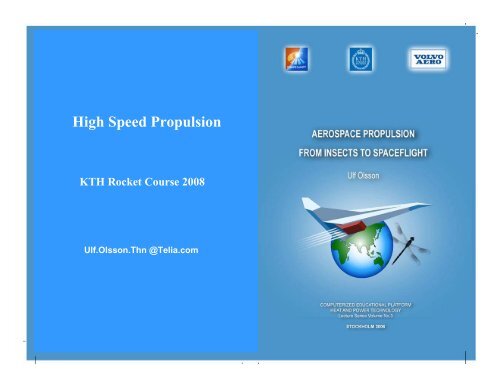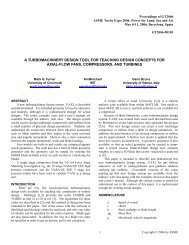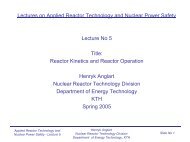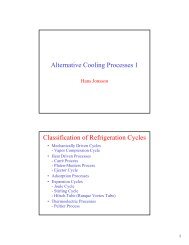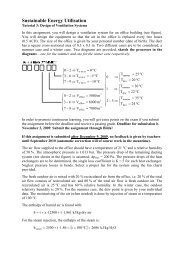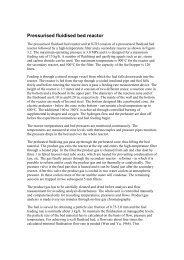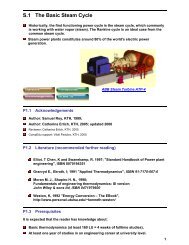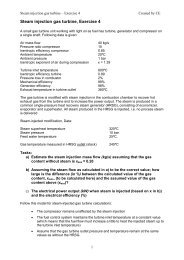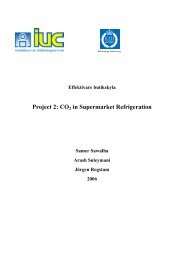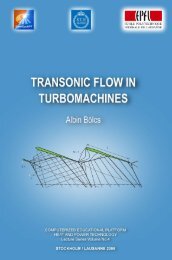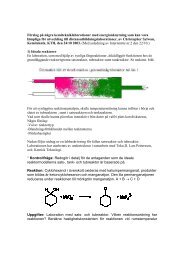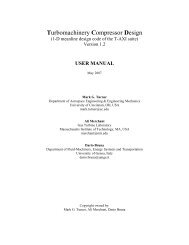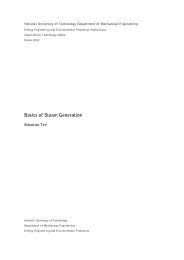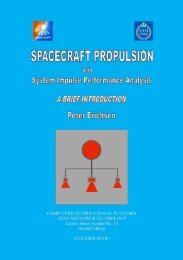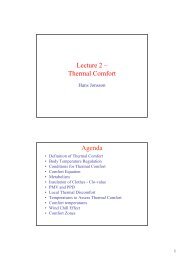High Speed Propulsion - KTH
High Speed Propulsion - KTH
High Speed Propulsion - KTH
You also want an ePaper? Increase the reach of your titles
YUMPU automatically turns print PDFs into web optimized ePapers that Google loves.
<strong>High</strong> <strong>Speed</strong> <strong>Propulsion</strong><br />
<strong>KTH</strong> Rocket Course 2008<br />
Ulf.Olsson.Thn @Telia.com
What velocities?<br />
Isaac Newton:<br />
Law of gravity 1687<br />
g<br />
=<br />
R<br />
g R<br />
2<br />
0<br />
0 2<br />
Perigee<br />
Apogee<br />
V<br />
= 2gR<br />
11200 m/s<br />
to leave earth.<br />
Hyperbolic velocity.<br />
V0<br />
=<br />
gR<br />
Circular velocity 7900 m/s.<br />
Mach 26.<br />
mg<br />
mV 2 /R
The spaceplane would give more flexible space access.<br />
(Eugen Sänger and Irene Bredt 1944).<br />
Wings and atmospheric oxygene
The SR71- the highest speed aircraft ever (Mach 3.2)<br />
The limits of the turbojet engine F = mV & ( −V)<br />
j
The turbine inlet temperature limits the thrust.<br />
F<br />
ma &<br />
0<br />
2<br />
= ( Tt<br />
4 / T0<br />
− 1)<br />
γ − 1<br />
Inlet<br />
efficiency<br />
Turbine<br />
inlet<br />
temperature<br />
Choking<br />
turbines<br />
Static<br />
pressure<br />
balance<br />
Choking<br />
bypass canal<br />
Rotational<br />
speed<br />
Compressor exit temperature<br />
Limits the pressure ratio
Efficiency %<br />
Turboramjet<br />
25<br />
20<br />
Max<br />
TIT,M tip<br />
Throttling down T t3 = T cm<br />
Main fuel=0, π c =1<br />
15<br />
10<br />
5<br />
Design<br />
point<br />
η =<br />
FV<br />
m&<br />
h V<br />
2<br />
f<br />
( + /2)<br />
Ramjet mode<br />
(afterburner)<br />
0<br />
0 1 2 3 4 5 6<br />
Close down the turbomachine at high speed<br />
Mach
Supersonic fan for less inlet losses<br />
LH2<br />
Precooling for extended turbojet operation
Efficiency %<br />
40<br />
35<br />
30<br />
Precooled +<br />
Supersonic fan<br />
25<br />
20<br />
15<br />
Base<br />
Supersonic fan<br />
10<br />
5<br />
Ramjet<br />
0<br />
0 1 2 3 4 5 6 7 8<br />
Mach
Fuel<br />
Jet<br />
Air<br />
The principle of a Pulse Detonation Engine (PDE)
V1-German WW1 pulsejet
p<br />
4<br />
Humphrey (PDE) constant volume combustion<br />
3<br />
Brayton (ramjet and turbojet)<br />
Constant pressure combustion<br />
0<br />
9<br />
v<br />
Volvo Aero<br />
-id/datum/ 27
η<br />
%<br />
40<br />
35<br />
30<br />
25<br />
20<br />
15<br />
10<br />
5<br />
PDE more efficient than ramjet – less fuel<br />
Ramjet<br />
•<strong>High</strong> efficicency<br />
•Light weight<br />
•Simple<br />
Pulsejet<br />
FV<br />
η =<br />
mh &<br />
f<br />
0<br />
0 1 2 3 4 5 6 7<br />
Fig. 18.4<br />
Mach
%<br />
40<br />
35<br />
30<br />
PDE has take-off thrust<br />
Same max speed:<br />
M Fa I a<br />
η = = mh h<br />
0 s 0<br />
/<br />
0<br />
&<br />
f<br />
25<br />
20<br />
15<br />
10<br />
5<br />
Pulsejet<br />
M<br />
max<br />
T ta<br />
2<br />
= ( − 1)<br />
γ −1<br />
T<br />
where stagnation temp = combustion temp<br />
Ramjet<br />
0<br />
0<br />
0 1 2 3 4 5 6 7<br />
Fig. 18.4<br />
Mach
The idea of the scramjet<br />
Increase M 3 to keep T 3 low to prevent dissociation (1560 K)<br />
⎛ γ −1 2⎞ ⎛ γ −1<br />
2⎞<br />
Tt<br />
= T0⎜1+ M0 ⎟= T3⎜1+<br />
M3<br />
⎟<br />
⎝ 2 ⎠ ⎝ 2 ⎠<br />
0 3<br />
1560 K<br />
Scramjet M >1 if 2 ⎡⎛γ<br />
+ 1⎞T<br />
⎤<br />
3<br />
M<br />
0〉 ⎢⎜<br />
⎟ −1⎥<br />
=6<br />
3 γ −1⎣⎝ 2 ⎠T0<br />
⎦
US scramjet test hardware
The jet speed of a scramjet<br />
0<br />
3<br />
4<br />
M<br />
=<br />
M<br />
3 4<br />
Constant Mach<br />
in combustor<br />
Kinetic efficiencies<br />
V3 = V0 ηki<br />
V4 M4a4 T4<br />
T<br />
= = =<br />
V M a T T<br />
t 4<br />
3 3 3 3 t3<br />
T<br />
V = V η ηη T<br />
t 4<br />
j 0 ki kc kn<br />
t3
The scramjet performance<br />
0<br />
3 4<br />
T<br />
= T<br />
t3 t0<br />
Jet speed:<br />
T<br />
V = V η ηη T<br />
t 4<br />
j 0 ki kc kn<br />
t3<br />
Note max stoich f=0.0291 for hydrogen<br />
Heat release:<br />
Specific thrust:<br />
( ) 4 3<br />
1<br />
p t p t b<br />
+ f C T − C T =η fh<br />
F<br />
(1 f ) V j<br />
V<br />
m &<br />
= + −<br />
0<br />
There is a max flight speed of the scramjet at F=0
The maximum Mach number of the scramjet<br />
F=0 at:<br />
M<br />
max<br />
( 1+<br />
f )<br />
( f)<br />
2 ⎡η<br />
hf η<br />
⎢<br />
γ − 1⎢⎣<br />
CT<br />
p 0<br />
1-ηke<br />
1+<br />
b s ke<br />
= −<br />
⎤<br />
1⎥<br />
⎥⎦<br />
Kinetic efficiency 65-75% gives max Mach number 10-15.<br />
Run fuel rich to reach a higher Mach number:
%<br />
The scramjet functions between Mach 6 and Mach 15<br />
35<br />
30<br />
25<br />
η =<br />
FV<br />
mf & ( h + V /2)<br />
0<br />
2<br />
0<br />
Kin effic 90%<br />
20<br />
15<br />
10<br />
80%<br />
f = f stoich<br />
5<br />
0<br />
Fuel rich f = 2f stoich<br />
0 5 10 15 Mach 20<br />
The efficiency of a Scramjet
Problems with the scramjet<br />
p. 549<br />
3 4<br />
Fuel injection shock waves<br />
Note:<br />
M<br />
M<br />
≈<br />
T<br />
T<br />
3 0<br />
0 3<br />
Incomplete combustion<br />
<strong>High</strong> combustor Mach numbers<br />
Very sensitive to kinetic efficiencies<br />
T<br />
V = V η ηη T<br />
t 4<br />
j 0 ki kc kn<br />
t3
Scramjet powered spaceplane<br />
Large intake with variable geometry
T t 4<br />
Small specific thrust surplus<br />
F<br />
mV &<br />
0<br />
γ −1<br />
2<br />
Tt<br />
0<br />
= T0(1 + M0)<br />
2<br />
= (1 + f) η T / T −1<br />
ke t 4 t 0<br />
Potentially catastrophic thrust loss at large drag
6<br />
I s / V 0<br />
V 0<br />
=circular velocity<br />
5<br />
The rocket has a higher specific impulse than the<br />
scramjet engine over about Mach 15<br />
4<br />
3<br />
2<br />
What about low<br />
speed propulsion<br />
1<br />
?<br />
Scram 6
Combined engines<br />
Air<br />
Liquid air<br />
LH2<br />
LH2<br />
LOX<br />
LACE-Liquid Air Combustion Engine<br />
LOX<br />
Precooled turboram-rocket<br />
LH2<br />
Air/LOX<br />
Ramrocket<br />
Pulsed ramrocket
6<br />
I s / V 0<br />
Specific impulse for spaceplanes<br />
Pulsed ramrocket<br />
5<br />
4<br />
Ramrocket<br />
Precooled<br />
Turboram<br />
I<br />
s<br />
F<br />
=<br />
m &<br />
p<br />
3<br />
2<br />
Scram<br />
1<br />
0<br />
Rocket<br />
LACE<br />
0 2 4 6 8 10 12 14 16 18<br />
Mach
Heat protection is a big problem<br />
K<br />
2000<br />
1500<br />
1000<br />
500<br />
Al<br />
Ti<br />
Ceramics<br />
Superalloys<br />
0 1 2 3 4 5 6 7 8<br />
MACH<br />
Stagnation temperature and materials
Tsiolkovsky equation with gravity and atmosphere<br />
Ordinary Tsiolkovsky:<br />
mc<br />
m<br />
0<br />
=<br />
e<br />
−V / I s<br />
Modified for aero and gravity losses:<br />
Konstantin Tsiolkovsky<br />
V<br />
m m<br />
c<br />
p dV<br />
1 exp( )<br />
m m I<br />
= − = −∫ η<br />
0 0 0<br />
f<br />
s<br />
Flight efficiency
Flight efficiency<br />
2<br />
V<br />
m<br />
R +<br />
L<br />
α<br />
mg<br />
The Lift-to-Drag ratio decreases with speed<br />
Conventional L/D=4(M+3)/M<br />
Waverider L/D=6(M+2)/M<br />
2<br />
D⎛<br />
V ⎞ g g<br />
η<br />
f<br />
= 1/(1+ ⎜cosα − ⎟ + sin α)<br />
L ⎝ gR ⎠ a a
Spaceplane trajectory<br />
q=50 kPa<br />
α<br />
Ozon layer<br />
50 km<br />
Stratosphere<br />
10 km<br />
Atmospheric pressure:<br />
p<br />
p<br />
sl<br />
=<br />
e<br />
−h/<br />
h<br />
0<br />
h 0 =6670 m<br />
1 1 p γ p<br />
q = ρV = V = M<br />
2 2 RT 2<br />
2 2 2<br />
M<br />
=<br />
2q<br />
γ pe<br />
sl<br />
−h/<br />
h<br />
0<br />
Flight at constant dynamic pressure q
Rocket<br />
q=50 kPa<br />
50 km<br />
Stratosphere<br />
Ozon layer<br />
20 km<br />
Spaceplane and rocket trajectories
6<br />
5<br />
I s / V 0<br />
PDE<br />
Effective average specific impulses<br />
4<br />
3<br />
Precooled<br />
Turboram<br />
5730<br />
V<br />
I<br />
0<br />
V<br />
0<br />
dV<br />
= ∫ η I<br />
eff 0 f s<br />
2<br />
1<br />
Ramrocket<br />
5480<br />
Scram<br />
Rocket<br />
3409<br />
0<br />
0 2 4 6 8 10 12 14 16 18<br />
<strong>Propulsion</strong> cycles for spaceplanes<br />
Mach
% take-off weight to satellite orbit<br />
m m = e −<br />
c<br />
0<br />
V0 / I eff<br />
20%<br />
Structure winged single stage<br />
Turbo/Scram/Rocket<br />
Ramrocket<br />
Stages<br />
10%<br />
Structure rocket<br />
Liquid<br />
rocket<br />
3<br />
2<br />
Payload %<br />
1<br />
Solid rocket<br />
Single stage<br />
Effective specific impulse m/s<br />
2000 4000
A jumbo to space?<br />
Yes, but how?<br />
I s / V 0<br />
14<br />
12<br />
Ideal engine η e =1<br />
I<br />
s<br />
F h V<br />
= = ηe( + )<br />
m&<br />
V 2<br />
p<br />
10<br />
8<br />
6<br />
PDE<br />
4<br />
2<br />
Turboram<br />
Scramjet<br />
m / m ≈ 0.4 ( η = η = 1)<br />
pl<br />
0 e f<br />
0<br />
0 5 10 15 20 25 30<br />
Limits to airbreathing propulsion<br />
Mach
Electricity; Magnetohydrodynamics<br />
The Soviet AJAX system<br />
Ionized boundary layer<br />
Virtual nose<br />
Electrical energy<br />
Magnetohydrodynamic airbreathing vehicle
Most powerful of all engines<br />
Humming bird 300 W/kg.<br />
Insect 60 W/kg.<br />
Gripen 2500 W/kg.<br />
Ariane<br />
20000 W/kg.<br />
Man 3 W/kg.


